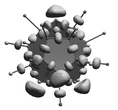The role of non-bonding electron pairs in intermetallic compounds
Abstract
The Electron Localisation Function, ELF pictorially visualises chemists’ intuitive ideas of single and multiple bonds as well as non-bonding electron pairs in molecules. The power of the representation of chemical bonds via ELF is that on the one hand covalent, polar, and ionic bonds are distinguishable, and that on the other hand ELF can be calculated for molecules and solids. This enables us to transfer the ideas of chemical bonding from molecular to intermetallic compounds. Localised two-electron-two-centre bonds and lone pairs are present in solid-state valence compounds (Zintl phases) as expected by the 8-N rule. In solids, lone pairs are generally more contracted than in molecules due to ‘lone-pair repulsion’. In intermetallic compounds localised electrons predominantly occur in the form of lone pairs. Lattice vibrations influence the strength of lone pair interactions and non-bonded interactions lead to an exchange of delocalised and localised electrons. Such a mechanism of local electron pair formation gives rise to ideas of a chemical view of the phenomenon of superconductivity in intermetallic compounds.


 Please wait while we load your content...
Please wait while we load your content...